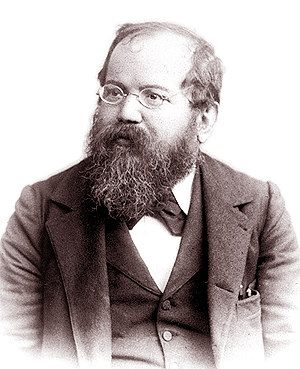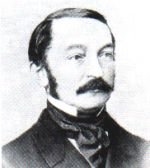
Howard Staunton was an English chess master who is generally regarded as the world's strongest player from 1843 to 1851, largely as a result of his 1843 victory over Pierre Charles Fournier de Saint-Amant. He promoted a chess set of clearly distinguishable pieces of standardised shape – the Staunton pattern promulgated by Nathaniel Cooke – that is still the style required for competitions. He was the principal organiser of the first international chess tournament in 1851, which made England the world's leading chess centre and caused Adolf Anderssen to be recognised as the world's strongest player.

The World Chess Championship is played to determine the world champion in chess. The current world champion is Gukesh Dommaraju, who defeated the previous champion Ding Liren in the 2024 World Chess Championship.

William Steinitz was a Bohemian-Austrian, and later American, chess player. From 1886 to 1894, he was the first World Chess Champion. He was also a highly influential writer and chess theoretician.

Karl Ernst Adolf Anderssen was a German chess master. He won the great international tournaments of 1851 and 1862, but lost matches to Paul Morphy in 1858, and to Wilhelm Steinitz in 1866. Accordingly, he is generally regarded as having been the world's leading chess player from 1851 to 1858, and leading active player from 1862 to 1866, although the title of World Chess Champion did not yet exist.

The Immortal Game was a chess game played in 1851 between Adolf Anderssen and Lionel Kieseritzky during the London 1851 chess tournament, an event in which both players participated. It was itself a casual game, however, not played as part of the tournament. Anderssen won the game by sacrificing all of his major pieces while developing a mating attack with his remaining minor pieces. Despite losing the game, Kieseritzky was impressed with Anderssen's performance. Kieseritzky published the game shortly thereafer in La Régence, a French chess journal which he helped to edit. Ernst Falkbeer published an analysis of the game in 1855, describing it for the first time with its sobriquet "immortal".

The British Chess Championships are organised by the English Chess Federation. The main tournament incorporates the British Championship, the English Chess Championships and the British Women's Chess Championship so it is possible, although it has never happened, for one player to win all three titles in the same competition. The English Women's Chess Championship was also incorporated into this event but did not take place in 2015 and was held as a separate competition in 2016. Since 1923 there have been sections for juniors, and since 1982 there has been an over-sixty championship. The championship venue usually changes every year and has been held in different locations in England, Scotland, Wales and once on the Isle of Man.

Johannes Hermann Zukertort was a Polish-born British-German chess master. He was one of the leading world players for most of the 1870s and 1880s, but lost to Wilhelm Steinitz in the World Chess Championship 1886, which is generally regarded as the first World Chess Championship match. He was also defeated by Steinitz in 1872 in an unofficial championship.

Joseph Henry Blackburne was a British chess player. Nicknamed "The Black Death", he dominated the British scene during the latter part of the 19th century. Blackburne learned the game at the relatively late age of 17 or 18, but he quickly became a strong player and went on to develop a professional chess career that spanned over 50 years. At one point he was one of the world's leading players, with a string of tournament victories behind him, and popularised chess by giving simultaneous and blindfold displays around the country. Blackburne also published a collection of his own games.

Szymon Abramowicz Winawer was a Polish chess player who won the German Chess Championship in 1883.

Romantic chess is a style of chess popular in the 18th century until its decline in the 1880s. This style of chess emphasizes quick, tactical maneuvers rather than long-term strategic planning. Romantic players consider winning to be secondary to winning with style. The Romantic era of play was followed by the Scientific, Hypermodern, and New Dynamism eras. Games during this era typically consisted of 1.e4 openings such as the King's Gambit and Giuoco Piano. Queen-side pawn openings were not popular and rarely played. The Romantic era is generally considered to have ended with the 1873 Vienna tournament where Wilhelm Steinitz popularized positional play and the closed game. This domination ushered in a new age of chess known as the "Modern", or Classical school, which would last until the 1930s when hypermodernism started becoming popular.

Dr Ludwig Erdmann Bledow was a German chess master and chess organizer . In 1846 he founded the first German chess magazine, Schachzeitung der Berliner Schachgesellschaft, which would later take the name Deutsche Schachzeitung.

Baron Ignatz von Kolisch, also Baron Ignaz von Kolisch (German) or báró Kolisch Ignác (Hungarian), was a merchant, journalist and chess master with Jewish roots.

Samuel Rosenthal was a Polish-born French chess player. Chess historian Edward Winter wrote, "He dedicated his life to chess-playing, touring, writing, teaching and analysing. Despite only occasional participation in first-class events, he scored victories over all the leading masters of the time. He also acquired world renown as an unassuming showman who gave large simultaneous displays and blindfold séances, invariably producing a cluster of glittering moves."

Gustav Richard Ludwig Neumann was a German chess master.

George Henry Mackenzie was a Scottish-born American chess master.

London 1851 was the first international chess tournament. The tournament was conceived and organised by English player Howard Staunton, and marked the first time that the best chess players in Europe would meet in a single event. Adolf Anderssen of Germany won the sixteen-player tournament, earning him the status of the best player in the world.
The Paris 1878 chess tournament took place from 17 June to 31 July 1878 during the Paris World Expo. The participation of George Henry Mackenzie and James Mason made it the first intercontinental tournament in Europe. Eleven double rounds were played. Wilhelm Steinitz was present as reporter for The Field.
Karl (Carl) Pitschel was an Austrian chess master.
Louis Eichborn was a banker and a strong amateur chess player who played a series of casual games against Adolf Anderssen who was among the best players in the world in the 1850s. Almost all of his known games are wins against Anderssen, found in Eichborn's papers after his death.
A school of chess denotes a chess player or group of players that share common ideas about the strategy of the game. There have been several schools in the history of modern chess. Today there is less dependence on schools – players draw on many sources and play according to their personal style.
 Adolf Anderssen (German Empire)
Adolf Anderssen (German Empire) Wilhelm Steinitz (Austrian Empire)
Wilhelm Steinitz (Austrian Empire) Gustav Neumann (German Empire)
Gustav Neumann (German Empire) Joseph Henry Blackburne (United Kingdom)
Joseph Henry Blackburne (United Kingdom) Louis Paulsen (German Empire)
Louis Paulsen (German Empire) Cecil De Vere (United Kingdom)
Cecil De Vere (United Kingdom) Szymon Winawer (Russian Empire)
Szymon Winawer (Russian Empire) Samuel Rosenthal (France)
Samuel Rosenthal (France) Johannes Minckwitz (German Empire)
Johannes Minckwitz (German Empire) Adolf Stern (German Empire)
Adolf Stern (German Empire)













